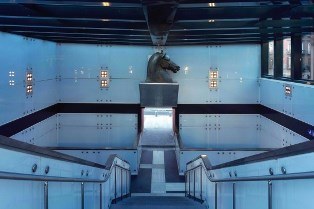
WTI Magazine #27 2014 Apr, 25
Author : Enrico De Iulis Translation by:
Gae Aulenti died less than two years ago, and for a strange effect of reverberation or echo, we hear about her a lot more today than when she was alive. A very active life, however.
She graduated in 1953 when Milan was full of post-war reconstruction with splendor and brilliance of ideas, with such a high concentration of talent to create a trend setting that continues today. Architecture, design, art and fashion are intertwined: they create, and explode into a thousand of exceptional cases.
In 1965 the first creation of Gae Aulenti comes to life: the lamp "Pipistrello" (Bat) produced by Olivetti will be a passport to the great commissions of the future, preceded by the infallible instinct of the Agnelli family that asks for the renovation of their house in Milan, mainly as a container of their huge art collection.
With excellent teaching activities at Politecnico di Milano, Aulenti arrives to the '80s with a very Parisian profile: the redevelopment of the old station in the "Gare d'Orsay" (Orsay museum), and the interior of the Centre George Pompidou (the structure of which was made by Renzo Piano). In this decade, she shows her ability to rethink big spaces for exhibition and rearrange the places of culture and their relationship with the moving user.
This concept will develop from here on a constant basis, also very close to the neoliberty current that she had embraced in the early years of college in Milan.
The neoliberty movement was opposed to the rationalism that seemed to have conquered the whole Lombard city, but also posed serious criticism towards organic architecture. The concept of the relationship between user and architectural element is recognized in every one of her interventions, whether internal as the renovation of Palazzo Grassi in Venice, or external as the street furniture of Piazza Ciulla in Alcamo, a sloping square characterized by the presence of a stream flowing beneath it.
The element that distinguishes Gae's work, almost a stylistic brand, is the flat facade, almost two-dimensional, a series of panels that create a smooth and light surface even if of dark color, as in the case of the Italian Pavilion for the 1992 Expo in Seville, the metro stations of Line 1 in Naples, and the recent restoration of Palazzo Branciforte in Palermo and its conversion to cultural center.
In Milan there is another of her famous works that sums up this particular vision of architectural presence: the square and the facade of the northern railway station in Piazzale Cadorna. Here, the concept of exhibition and together container for construction is overturned: the square is treated as the container herself, and the facade of the station is the backdrop to the famous sculpture regarding the needle and the thread, which celebrates in one shot the network communication of the city and its largest business, known all around the world: high fashion.
Only one of her works does not have the idea of the two-dimensional background, still being a museum: The Papal stables of the Quirinal in Rome. In her famous restructuring, Aulenti plays with the pre-existing, making very few installations, even taking away a lot, leaving the rough taste of a masonry stable but also its enormous elegance, being both papal and from seventeenth-century. It undoubtedly is the more beautiful museum space in Rome, and the more suitable for large-scale productions: a place which saw crowds of people visiting exhibitions of Caravaggio, Tiziano, Antonello da Messina, Giovanni Bellini and Tintoretto.
Gae Aulenti was a woman with an innate instinct of education, that used architecture and design to drive even the most inattentive person towards art and culture: it is not by chance that Milan has named after her its most recent square, embedded in the most futuristic city architecture.






